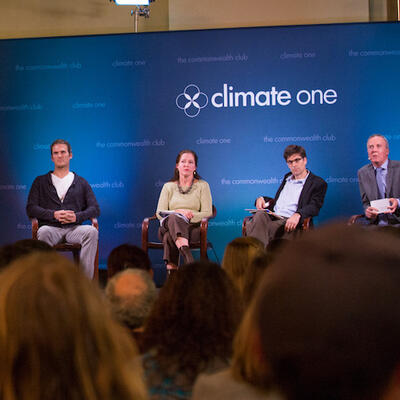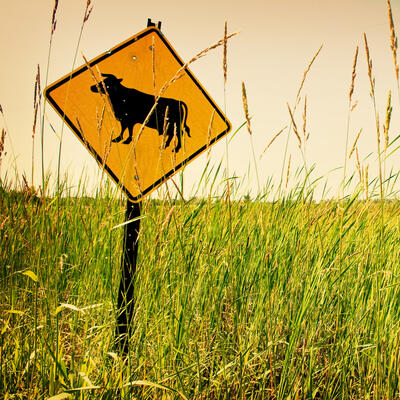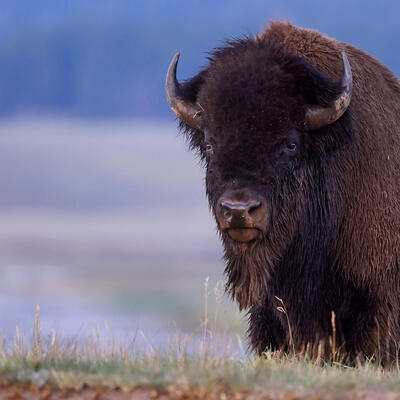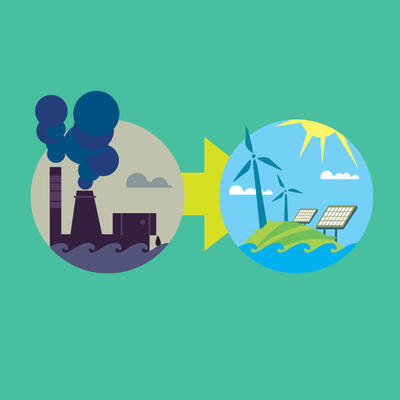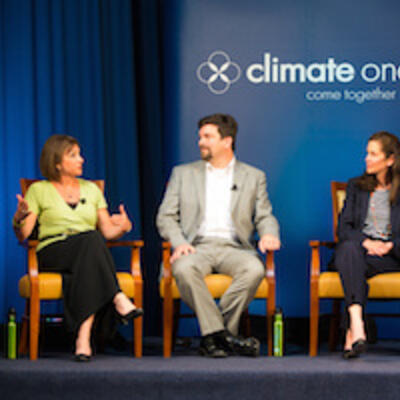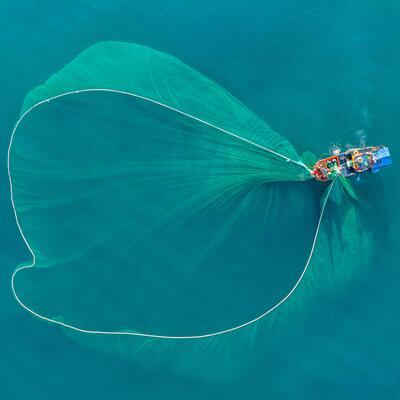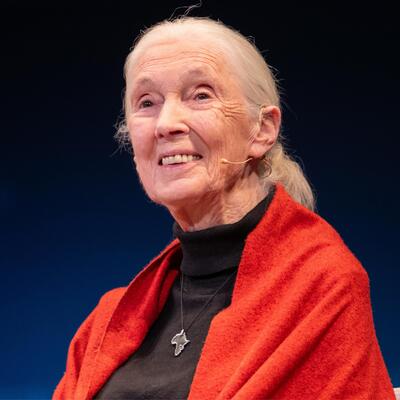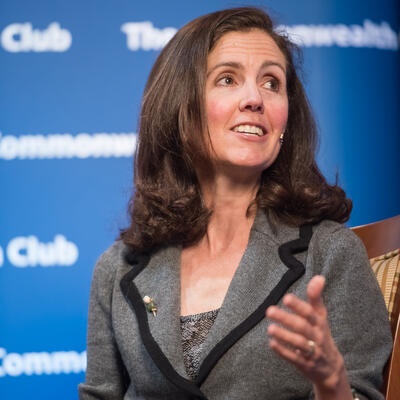
Down and Dirty
Guests
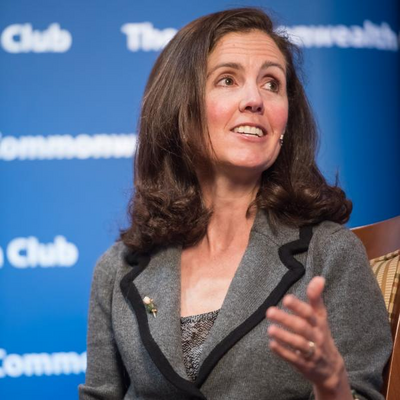
Diana Donlon
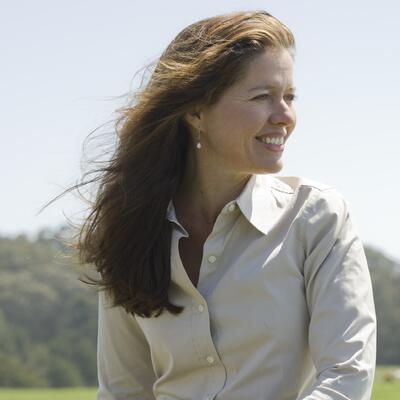
Nicolette Hahn Niman
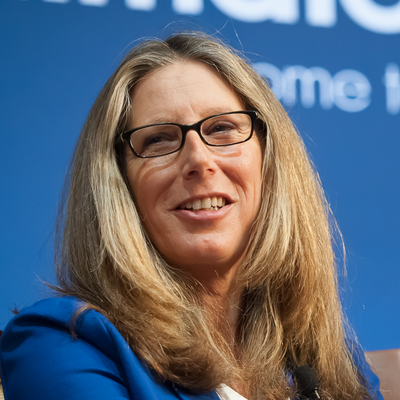
Whendee Silver
Summary
The meat industry has been much maligned for its part in climate change. But can raising cattle in pastures help turn global warming into global greening?
Diana Donlon, Director, Cool Foods Campaign, Center for Food Safety
Nicolette Hahn Niman, Author, Defending Beef: The Case for Sustainable Meat Production (Chelsea Green, 2014)
Whendee Silver, Professor of Ecology, University of California, Berkeley
Full Transcript
Greg Dalton: This is Climate One, changing the conversation about America's energy, economy and environment. I'm Greg Dalton. And today, we're talking about hamburgers in a hot world. Environmentalists have long had a beef with cows, portraying cattle as ecological villains tearing up landscapes and releasing potent greenhouse gases that drive severe weather. Now some advocates were saying cows can actually help heal the climate and reduce severe weather. Burning fossil fuels has pumped massive amounts of carbon dioxide and other pollutants into the atmosphere and oceans, fundamentally changing the biochemistry of the planet. Soils on the other hand are depleted, and stashing carbon in the ground could be a winning strategy.
Over the next hour, we'll discuss whether cattle have gotten a bad rap and if cow patties could help save humanity. We’ll also talk about free range beef, industrial agriculture, what consumers should know about their meat. Along the way we’ll include questions from our live audience at the Commonwealth Club here in San Francisco. We’re joined by three guests; Diana Donlon is Director of the Cool Foods campaign, the Center for Food Safety and Nicolette Hahn Niman, is a cattle rancher and author of Defending Beef and also Righteous Porkchop. Whendee Silver is a professor of Ecology at UC Berkeley who studies range lands. Please welcome them to Climate One.
[Applause]
Greg Dalton: Let’s begin. I want to ask you briefly about your sort of your food story. What you ate growing up and what you’ve eaten now and how your diet has evolved. Diana Donlon, let’s begin with you growing up in --
Diana Donlon: Thanks Greg. Well I grew up here in San Francisco and my mother fed me a very actually nutritious diet. We didn’t eat a whole lot of meat. We used to get things delivered and kind of eat in season and being here in California we had always a variety of food. But I went up to college and took a course in human ecology where I learned that eating meat was bad for the planet so I gave it up at age 19 and didn’t eat again for quite some time, I won’t say exactly how long.
But two decades, well, I’ll come clean. And then I had, in between that time I had two children back to back and got really exhausted after the second one was born. And I went to a nutritionist at my local market which is Good Earth in Fairfax which, just everything is organic, everything is really clean and seasonal and local and so forth. And they said, “You know, you really are depleted in meat, eat red meat” and I was shocked. I really was shocked and so I started eating a little tiny bit and I still only eat it on occasion. But I do find that I have better health and just always know who raised the meat and where it came from and seek out pasture-raised. So that’s my meat story.
Greg Dalton: Nicolette Hahn Niman, how about you?
Nicolette Hahn Niman: Well, it’s interesting I didn’t -- I’ve known Diana for well but I didn’t know we have that parallel in our biographies. Because I also, I grew up in Michigan, my mother was from Germany and we had a lot of sort of meat and potatoes. Actually potatoes almost all the time [Laughter] and my father is German-Irish so that was fine with him.
But I went to college and majored in Biology and was already really active in environmental causes when I started college and I also was sort of continually exposed to this notion that if you were a good environmental citizen you did not eat meat, especially beef most of all. And so I remember very deliberately choosing to stop eating beef first, because of it’s what I believe were its ecological impacts and especially the connection that I believe that I had to the clearing of the Amazon. That was -- I won’t say the exact number of years, either [Laughter] but it was a couple of decades ago.
I’ve continued to be a vegetarian but interestingly, I’m now involved in raising cattle myself and I have two young sons to whom I do feed meat.
Greg Dalton: Interesting, okay we’ll get more to that later. Whendee Silver, your story.
Whendee Silver: Well, so I grew up in Southern California in a family of big meat eaters. And when I was 13, I started to have problems with my stomach and my pediatrician said, you know, to my mom just, you know, it seems like that I was having problems after eating pork chops and steaks and some of the heavier food that my mom -- my mom was German who was a great cook. But there was a lot of meat and a lot of kind of good, dense, good German meals. And so he said why don’t you just cut back or maybe cut the meat out of the diet and see if that helped, and it helped a lot. So from the age of 13, I stopped eating mostly red meat. And then slowly work chicken and turkey out of my diet because I didn’t really like it. I still do seafood occasionally and other protein sources but as an adult now, I’ve gotten much more interested in trying to figure out what the carbon footprint is of different protein sources and that’s informed my choices as well. So my family still eats meat and I still cook meat occasionally although we don’t eat it very often. And we try to make good decisions from a climate perspective and an environmental perspective.
Greg Dalton: Picking up on that, the world -- the Federal Food and Agriculture Organization did landmark study some years ago called Livestock’s Long Shadow that had a big impact on the way that the climate impact of animal protein is viewed. Whendee Silver, what’s your assessment of that report, it’s been quite controversial, it’s been amended and we’ll get the others in on this, but how did that kind of change the way people view animal protein for human consumption?
Whendee Silver: You know, I think that was a big wakeup call to a lot of people. You know, we’ve known for a long time that agriculture in general has the potential to emit a lot of greenhouse gases.
What we don’t hear about all the time is the fact that agriculture also has a chance to be part of the solution. And my biggest gripe with Livestock’s Long Shadow was it really was a very one-sided treatment. It really focused on, you know, what are the potential emissions, what’s the bad management that’s going on. It gave very little space and consideration to good management practices, how widespread those are, what the potential sustainable, sustainability questions are with regard to management. So I’m somewhat critical, I think that there is more data coming out that I think the future iterations of that report are going to be, are probably much more accurate and much better. I also think that there is data coming out showing that there are higher emissions in some sectors than we thought previously as well. So, it wasn’t based on a lot of data but there’s more data becoming available which will make it a more useful report for policy.
Greg Dalton: Nicolette Niman, you’re also critical to that report. Anything other than what Whendee just said?
Nicolette Hahn Niman: Well, I largely agree with what Whendee just said. I think there’s a lot in it that’s good and correct and was important, because it certainly highlighted an issue that hadn’t gotten that much attention which is sort of what are the climate impacts of food production and agriculture, but specifically meat production in that report. But there were quite a few things that I found troubling and I talk about the report in a lot of detail in my book Defending Beef actually. And for example, one of the things that the report did was it treated very specific problematic, ecological behaviors to the entire sector. So, specifically, deforestation was an enormous portion of the emissions that were included in the calculations.
And while in fact deforestation is a really important and urgent issue, if you -- almost all of the emissions that the report was talking about that were added into the meat sector are from very specific geographies in the world. So Indonesia, Brazil, Sudan, there are certain parts of the world that are really hotspots for deforestation. Those were attributed to the entire meat sector and it’s really inappropriate, especially when people like talking about the American Cattle Sector and they refer to those figures, because there’s absolutely no connection at all. In fact, in the United States, the number of forested acres has been steadily increasing for decades.
So it has no connection to what ranchers in the United States are doing or the beef that Americans are eating. So that’s a lot of what I find problematic about that report.
Greg Dalton: It was broad brush. Though still, Dr. Rajendra Pachauri who’s an Indian, chair of the Intergovernmental Panel on Climate Change, U.N group of climate scientists says “One thing that people can do is reduce their meat consumption.” Diana Donlon, is that the right thing?
Diana Donlon: Well at Center for Food Safety where I work, we draw distinction between confinement animal agriculture or industrial animal agriculture, otherwise known as CAFOs and pasture raised --
Greg Dalton: So factory farms --
Diana Donlon: Factory farms versus animals that are raised outside on grass. And there really is a world of difference between the two. I mean in the confinement model, that’s when you get the heavy dosage of antibiotics that leads to antibiotic resistance to antibiotic residue in the meat, to the manure lagoons, to the loss of biodiversity to the ground water contamination, to a whole suite of issues that are not associated with the correct pasture management. So it’s really for us the question of management.
Greg Dalton: But the average American today, if they go out and buy beef or hamburger it’s going to be factory meat, right? So are you saying that if you can get grass-fed meat that’s okay but stay away from the factory stuff?
Diana Donlon: Absolutely stay away from the factory stuff to the extent that you can, in fact just, you know, draw line in the sand and say I’m not going to do it. Because that’s the system that needs changing. 97% of the meat comes from that system in this country. Only 3% is the grass-fed, so there’s a tremendous opportunity to shift away from this terrible model towards a model that can be, again when management practices are well done, regenerative.
Whendee Silver: Can I --
Greg Dalton: Whendee Silver and then we’ll get Nicolette.
Whendee Silver: Yeah, I just want to make a comment on that in that, while in principle I completely agree, one of the problems is that we don’t have enough grassland area or rangeland area to support the demand. Even a Meatless Monday demand, there’s not enough grassland area to support that much cattle production in the US. And so my concern is, well what’s going to happen if we push people away from more confined animal feeding operations, not that I necessarily support that from a climate perspective, but that’s going to lead to this more deforestation as we import more beef from places like the Amazon or Indonesia or Africa where people are deforesting to grow meat for an export market. So, I think that we’ve got to look at it both ways. I think that if we can do a better job of managing as much cattle as we can on the rangelands we have available and make it sustainable. We also need to look at the other side and can we use -- I don’t want to say, I hesitate to say what people often consider bad words like confined animal operations. But other management approaches that don’t rely so heavily on our rangeland systems to be able -- and do a better job of managing those environments as well. I just don’t think that we’re going to be able to make it on grass alone.
Greg Dalton: Because there’s not enough grass. Nicolette Niman.
Nicolette Hahn Niman: I wasn’t going to talk on that but let me first respond to that point. I think that’s a matter definitely for debate.
The Savory Institute which is based in Colorado and does work around the United States and all over the world on sustainable grazing has specifically looked at quantifying that issue. And they tried to assess if you took all of the cattle out of the feed lots, if you return them to grass, if you took all of the areas that are currently raising green for those animals and return them to grass, could you produce all of the meat for current demands? And they found that actually there’s a 30% surplus in the United States in terms of the total amount of land that would require to do that. So I think that point is definitely up for debate.
The second issue is going back to sort of that point about what the right thing is for a consumer to do. And I think boycotting an industry does not change it. So if we want to build sustainable food systems we have to buy the kind of food that we think is actually creating regenerative landscapes and soils. And so if you simply stop eating meat, I mean I’m a vegetarian myself so I’m not, you know, I don’t tell people go out and eat meat or go buy more of it. But I think for people who are omnivorous, I don’t think simply stopping to eat meat is necessarily the most constructive step.
Greg Dalton: But stopping eating factory meat and eating the grass-fed stuff, doesn’t that send a signal that the grass-fed farmer, that the boutique farmers, you pay a higher premium, that that eventually more people buying that products, send a market signal and there’s more growth there?
Nicolette Hahn Niman: Well, what’s happened in the organic sector for example is it is the fastest growing sector of the food industry, has been for a long time. And so you’ve seen shifting, you’ve seen transitions towards organic from conventional. And I think that’s exactly what will begin to happen in the meat industry -- I mean is already happening because the grass-fed beef sector is the fastest growing sector in the beef industry. In fact, overall consumption of beef has been declining in the United States for several decades. But there has been a rise in grass-fed beef consumption. So anybody who’s looking at the industry and in fact I read a lot of the trade journals on a regular basis and you can see this talked about all the time. There is a recognition that we need to move in that direction among the conventional beef industry.
Greg Dalton: This idea of convergent of the corn farmer suddenly not raising corn anymore and having grass and cows on that land, could that corn farmer make as much money with cow pastures as they could with corn? Is that even an economically viable option?
Nicolette Hahn Niman: Well, I mean I haven’t seen anyone specifically calculate that out. But when you translate, if you consider all of the inputs that are required for any kind of crop production especially conventional crop production -- so you’d have to have, you know, the seeds and the, I will say the plowing and the planting, the labor, the fossil fuels, all of the agricultural chemicals that are added. And you compare that to simply allowing the land to be undisturbed except for the presence of the animals grazing on it. The inputs are quite different, you know, the math is quite different. So I think you couldn’t just take a piece of land and take the corn off of it and put cattle on it and earn more money, it wouldn’t work like that. But for a farmer to transition the total operation of what they’re doing from crop production to grazing animals, yes, I think that that could be economically viable.
Greg Dalton: Diana Donlon.
Diana Donlon: Well, one thing with our current model is that there’s so many subsidies. So if you’re a corn farmer, you’re getting subsidized, you’re getting insurance. In fact, there is a disincentive to conserve the land base, you know, the farmers are told to plow from here to there and we’ve lost, we only have 3% of our native prairie left. And those were systems that were in perennial grains that were deep rooted and what that deep root mass does is hold the soil carbon way down there. When you have this annual production, you have very shallow roots and you have the carbon going right back into the atmosphere. So, you know, we need that. We need to conserve that last 3% of prairie that we have left. And stop propping up a system that -- we’re growing all these corn not to feed people but to feed cows and cars, so biofuels.
Greg Dalton: Whendee Silver, you’re an expert on rangelands, grasslands. Tell us what percentage of the world’s lands are these grasslands and why are they important, why should we care about grasslands?
Whendee Silver: So, rangelands or grasslands cover at a global scale about 30% of the land surface. It’s the dominant cover type and the dominant land use type globally. And in California, it’s 40% to 50% of the land area. And in fact we’re the biggest dairy producing state in the country. People don’t realize that, I mean we’ve been talking about beef cattle but dairy is in California is a much more important commodity. And as well as the fact that it’s growing globally. So countries like China and India which traditionally had much smaller dairy industries. A recent paper by Dr. Justine Owen in my lab showed that these sectors growing can have, you know, very large impact on greenhouse gas dynamics. And the potential to potentially mitigate greenhouse gas dynamics by using a key resource, which nobody wants to call a resource, but it’s cattle manure. And so the poop that we don’t really like to think about but the bottom line is it’s a huge emission source and also a huge potential offset. If we can convert that to things like fertilizer, organic fertilizer.
Greg Dalton: Nicolette Niman, you write in your book that when cows poop you celebrate. I remember when I was -- the parent, you know, my baby having, you know, where they have a little -- I mean, it’s cause for celebration. But I’ve never thought about a cow poop as a cause for celebration.
Nicolette Hahn Niman: Well, in my first book Righteous Porkchop I kind of go through this whole comparison between traditional farming where manure was an incredibly important asset. Because when you’re thinking about food production from an ecosystem standpoint, you really have to think about all of the nutrients and how they’re utilized by all of the living entities, the plants and the animals. And then how they’re returned or not returned back to the soils to be either regenerative or to be depleted.
And when you have traditional farming systems there’s a lot more of that versus today, especially the animal sector in the United States and much of the world. You have a complete segmentation, you have a separation where the feed is grown and then it’s transported to the animals. And then there’s so much manure, I mean this is a little bit different when you’re talking about cattle for beef. But in much of the animal food industry, especially dairy, pigs and chickens and turkeys, you have so much concentration of the animals and then you have to transport the manure away from the place where the animals are. And so you just have this complete separation of the resource, the natural resources and the land, and the animals. It’s not a connected and regenerative system. So what’s great about cattle on pasture, whether they’re part of a dairy system or a beef system, is that you have that whole cycle taking place. You have the capture of the solar energy in the vegetation that’s coming up out of the ground and then the animals are using that, they’re using in most cases naturally occurring forages, which are things that humans and most other animals cannot use for nutrition. They’re converting it, miraculously really, to meat and milk and then humans are using that food. And as those animals are growing and living on that space, they’re not only returning the manure but they’re also returning their urine. And I was reading some research recently from Australia where they were quantifying when you have animals, cattle on grasslands they get between typically 70% to 90% of their water comes from the growing vegetation. I mean it depends on the season and on the lands that you’re on. But so, you’re actually utilizing the resources in that ecosystem in a much more sensible way than animals that are being separated from land. So, yes, manure on a pasture based farm is a cause for celebration.
Greg Dalton: Nicolette Hahn Niman is author of Defending Beef, we’re talking about cows and cattle at Climate One, I’m Greg Dalton. Whendee Silver, compost can come into the picture here and how can manure and compost be combined in a way that can really change landscapes and become a resource and help the climate situation?
Whendee Silver: Yeah, that’s a really good question because one of the problems from what Nicolette was talking about, about separating the cows, you know, taking them off the rangeland as a kind of a regular part of their day and their lifestyle. And actually I have to say that a lot of cows both in the dairy and the beef industry spent part of their lifecycle on grass. But they are also confined during part of their lifecycle. And what the biggest greenhouse gas footprint or climate footprint from these industries is from that manure that’s piling up, especially in the dairy industry. If you take that material and you just spread it back out on the rangelands, which is what a lot of ranchers do in this region and in the Western US, you have a lot of greenhouse gas emissions particularly nitrous oxide which is a super potent greenhouse gas. So one molecule of nitrous oxide is like 300 molecules of CO2. So that’s way, way more potent. So if you just spread out that material out on rangelands, you pretty quickly offset any benefit that you would get by adding that material back on, growing more grass, pulling more CO2 out of the atmosphere.
But, if you take that material and you mix it with agricultural waste or urban green waste and you compost it, you dramatically lower the rate in which it emits greenhouse gases. It slows everything down. It slows down the rate at which it breaks down, it gives it more chance to work its way into the soil. It sticks around for a longer period of time. Our research is showing now that we’ve seen from a one-time application of compost, just the dusting on rangelands, we’ve seen an increase in plant growth for six years, it’s continuing to go.
We see an increase in the soil carbon storage, not just from the stuff we added in that compost but also from the plants that are growing. And our models, our computer models suggest that this is probably going to go on for about 30 years. And in about 100 years we’ll break even. And then we, you know, then we’re back to where we started again. So this is a potential mechanism to really take carbon that would have blown up into the atmosphere, or nitrous oxide, these potent gases, and figure out a way to stick it in the soil and store it for a longer period of time.
Greg Dalton: And is this happening anywhere in real life, or these are couple test plots in in Marin? I mean are ranchers doing this?
Whendee Silver: Yes, actually they are. Definitely there are some test plots and one of them -- we can get back to this but I have a bit of a gripe with the Savory Institute in their approach. One of the things that we felt that was really important and needed to be inserted in this discussion was very rigorous science. And so we have replicated, we’ve done multi-year studies on multiple sites. We’ve used both the UC sites and private ranches, where we’ve been able to control the environment and really do these experiments well. We got the idea though from the ranchers. So we started off with some early meetings where we got the ranchers together and we said, “Well, we’re really interested in seeing what the greenhouse gas emissions are from your operations and whether or not there’s any potential to lower those emissions. See if you maybe could participate in carbon markets or greenhouse gas offset programs.” People were really enthusiastic. And one of the things that came up, they said “Well, you know, we’ve been taking all of these waste that we’ve been paying to get shift off of our land, and composting with whatever we can get.” Almond hulls, one rancher was using almond hulls, using other agricultural waste products they get for free or get for cheap, mixing it in. And then just having these compost rows on their ranches. And they said, “You know, what’s the cause or benefit of this?” and when I first started I said “Oh, this is going to be great, we’re going to see all kinds of good greenhouse gas emissions” and to be honest as a scientist it’s a little easier to publish the world is going to hell instead of the world is getting better.
And so, you know, we are thinking well this will be really interesting to see. You know, I’m predicting that we’re going to see lots of greenhouse gas emissions. And much to our surprise we actually saw low, low greenhouse gas emissions, much lower than we predicted. And the amount of carbon gain in the ecosystem way more than offset the amount of carbon loss.
Greg Dalton: Diana Donlon, how could this be part of a carbon solution, climate solution?
Diana Donlon: Well I’m really glad you asked that question. Because the Food and Animal Organization, the FAO, has declared 2015 the Year of the Soils. And so we all know just, you know, quickly to review, that our atmospheres are overwhelmed because there’s too much CO2 in the atmosphere. Our oceans are acidifying because there’s too much CO2 in our oceans. But our soils are actually starving for carbon. Rattan Lal, who is one of the preeminent soil scientists in the world who’s at Ohio State University, his estimate is that 50% to 70% of the world’s agricultural lands, the carbon is severely depleted on them. And so we have this world opportunity to rebuild carbon around the world by using all these different methods including composting. But just, you know, using common sense too. I mean there’s this law of return, we come from the earth and we go back to the earth. And when we take all our waste and we put it in a landfill instead of putting it back into the ground, it comes back to haunt us as methanes. So by rebuilding soils around the world it’s low cost, it’s low risk, it doesn’t involve geo-engineering. It can be done universally; it can be done at scale. So it’s a really exciting thing to bring to this climate conversation in addition to focusing on emission reduction.
Greg Dalton: Whendee Silver, if California were to not use industrial fertilizer on its crops and use cow manure and compost -- could that happen? What would be the impact?
Whendee Silver: Oh, the impact would be huge. So we’ve done some preliminary calculations and it suggests that -- these calculations suggest that we could save somewhere between one and eight teragrams of CO2 equivalent per year. What’s a teragram, right? That would be enough to offset all of the livestock industry in any given year. So just by switching from an inorganic fertilizer, the kind of fertilizer that you buy mostly in a bag that’s made with lots of fossil fuels and, you know, high-energy cost. This is not even counting the energy costs for the making the fertilizer but just the emissions from adding that fertilizer, that inorganic fertilizer onto soils. If you were to take the organic stuff, the compost and manure and add that, especially the compost and manure, and add that on, you would completely offset the livestock sector in the state.
Greg Dalton: Nicolette Niman, if composting has such great potential why aren’t we doing more of it? What are the obstacles, is it that it takes investment by municipalities? Even Marin doesn’t collect a lot of -- a liberal place that doesn’t collect a lot of curbside composting et cetera. So what are the obstacles to getting more composting, if it’s such a big potential as we just heard?
Nicolette Hahn Niman: Well, I’m not sure if I’m the best person to answer that. But I would say the entire food system and agricultural system the way it is today, there’s so much entrenchment in the status quo there’s so much, there’s so many barriers to changing it. Because there’s so much invested in it, I mean the entire system is heavily dependent on and connected with the fossil fuel industry, with the chemical industry, with the pharmaceutical industry. And none of those entities wanted to radically change because that means -- I actually had the opportunity to speak with the president of Shell Oil a couple of years ago and I said to him, I said I’m going to say something to you that you’re going to think is absolutely ridiculous but I’m going to say it anyways.
I’m going to say to you “What if you guys stepped out and said, we know that the food system is overly dependent on oil and fossil fuels. And so we as a fossil fuel company don’t think that’s a good use of fossil fuels. And we want to support the transition of the food system away from fossil fuels.” He said, “That’s an interesting thought, I’ll think about it.” [Laughter]. He did not commit to that strategy. But there’s an enormous connection right now between major, multinational industries and our current food system. So I think all of these types of transitions, while incredibly sensible and appealing when you look at just like what the benefits are, there are massive obstacles towards any kind of big shift. But at the same time lots of small movements in that direction I think are beginning to happen and I think there’s reason for optimism.
Greg Dalton: And here’s one corporate one that was in the news recently. General Motors is paying a grassland farmer to not mow down some grass and they say that’s going to save 40,000 tons of CO2. So here’s a car company paying someone to keep the grass in place because it’s going to keep the carbon there and that means they can keep on selling their cars. Whendee Silver, what does that say about the potential for markets and for monetization of increasing the economic value of grassland?
Whendee Silver: Well, you know, so that this -- our research contributed to a protocol that was recently passed by the American Carbon Registry. Which now allows people to use composting and applications to rangelands as a way of offsetting their greenhouse gas emissions. So it’s already out there. And I agree there are some barriers but I guess maybe because we live here in the Bay Area and we’re fortunate that we have a lot of progressive thinkers and a lot of progressive municipalities. So, you know, it’s already happening. You know, Berkeley compost, the city of San Francisco has been in a lot, you know, lot of conversations that we’ve been having about what to do with their excess waste and how they can participate in this and how can they offset some of their greenhouse gas emissions.
By contributing to practices that we’ve known for a long time work well. These are good common sense practices, they’re not magic. They’re taking what most people see as a problem waste management and turning it into a solution helping to mitigate climate change. So I actually, I’m a little bit more optimistic. I think that there are not that many barriers, it’s already moving in that direction. I think California is going to be a real leader in this area.
Greg Dalton: Diana Donlon, tell us about Russ Lester, who’s that? Tell us the story.
Diana Donlon: Oh he is an organic farmer up in Dixon. And he has a walnut orchard and I have the pleasure of conversing with him last summer. And he was telling me that he’s been composting on his land and his orchard for years and built up the soil organic matter. And as a result, has weathered the drought better because soil is a sponge and when it’s living and healthy it can hold a lot of water. In fact, the NRCS, the Natural Resources Conservation Department of the United States, tells us that if there’s 1% organic matter in the soil in the top six inches of the soil profile, it can hold 27,000 gallons of water. So that’s a lot of water when you’re looking at a terrible epic drought that seems to be prolonged. And Russ, you know, he’s weathering the drought very well but he has looked across and see that his neighbor doesn’t use the same practices that he does. And so, you know, the water is actually percolating down on Russ’ side of the road and recharging the aquifer but not so on his neighbor’s, where when there is a rain event, the top soil tends to wash away and the water is what they call ineffective because it doesn’t recharge just goes away as does the soil.
Greg Dalton: Diana Donlon is director of the Cool Foods Program at the Center for Food Safety; you’re listening to Climate One. I’m Greg Dalton. Allan Savory is a controversial figure in grasslands areas, and he talks about erosion, desertification. Diana Donlon, his TED talk has been viewed millions of times, what do you think of Allan Savory?
Diana Donlon: Well, I think he’s a lovely gentleman. I have met him and he’s a wildlife biologist who grew up in Zimbabwe. And I think that he’s polarizing because he has a really unusual approach. But I’ve not only met Allan but I’ve met a young woman who works with him named Precious Phiri. And Precious is a woman that grew up hungry in Zimbabwe. She was orphaned at a very young age and had the opportunity to work with the Holistic Management Center that they have there in Zimbabwe. And the figures are pretty astounding. The country of Zimbabwe, only 1% of the land is arable with -- the rainfall is sufficient in this 1% for farmers to farm, 9% with irrigation, but 90% of the country is desertified. And so Precious works with the communities where she lives to implement this rotational grazing and they’ve had significant results in terms of the grassland restoration, biodiversity restoration and water holding capacity. So as much as I admire Allan, I really admire Precious because she is living it and spreading this effective tool. She sees livestock, proper livestock management as a tool to help people be self-sufficient.
Greg Dalton: Nicolette Niman, Allan Savory? Is he on to something?
Nicolette Hahn Niman: Well, I think he’s an iconoclast and that’s why he’s polarizing. Because he’s, he doesn’t like or believe in feedlots or the industrialized way of raising cattle.
So the cattle industry doesn’t like him, ranchers generally are skeptical of him. He criticizes a lot of things that are being taught in sort of traditional rangeland and ecological classes and universities, including his whole own education that he had and the way he started out when he started his career. And environmentalists and vegans don’t like him because he thinks that cattle are part of the solution. And most of them tend to think that they’re part of the problem. So it’s very obvious why he’s controversial.
The question is, is he saying something that makes a lot of sense? And I believe that he is. And a lot of what he’s talking about in his speeches and in the TED talk and his writings and among the people that he works with all around the world is that we had enormous herds of grazing animals, large megafauna, that covered much of the globe for much of the history of the, well, since life began at least. I mean, when you talk about geological time all animals are relatively recent on the planet. But he argues that the disappearance of those large animals, not just the grazing animals but also the predators, which were also having a lot of impact on the globe. And they were also having a lot of impact on the herbivores by keeping them densely congregated and keeping them in motion. And that essentially, those animals are almost gone today on the globe. And that without those animals we can’t have properly functioning ecosystems. And so he believes that when you compare all of the possible solutions, I’ve never heard him specifically talk about rewilding, but that would be one of the things that people talk about as a way to sort of reintroduce the predators and the grazing animals that were once there. When you look at all of the possible solutions in terms of their feasibility, he argues that domesticated cattle are the single best way to mimic those disappeared wild animals. And I think that’s a very credible argument, it just makes a lot of sense.
Greg Dalton: Whendee Silver, is Allan Savory credible?
Whendee Silver: From a scientific perspective, I have and -- I and my colleagues even those of us who aren’t from traditional rangeland ecology programs, I’m a biogeochemist. I’m not a traditional rangeland scientist, nor was I trained in a traditional program. But I look at what he’s done from two perspectives.
One, is I think he’s raised a lot of awareness which has been a very positive thing. I think that people looking at the land and trying to understand how can we better manage land for feeding people, which I think is absolutely critical. And also for helping to slow climate change is also very important. My primary concern comes from prescriptive management approaches that he’s arguing for that have no basis unfortunately in the scientific literature. We have looked and looked; we have talked to his group and said “Show us the data. We want to see the data. You know, we’re supportive in that we want to look at the data with you together and think critically about this.” And it’s just not there. Some of the practices that he pushes are common sense. If you take areas that are heavily overgrazed, especially continuously grazed by a large number of animals, you’re going to degrade those ecosystems. If you cut back the grazing intensity in time and potentially in space, those systems are going to recover to some degree. And he shows these beautiful pictures of desertified and green and he says “The only way you’re going to get there is through this approach.” And the scientific community says “Well, that’s not really true. There’s multiple different approaches you can use to get to that end product.”
And actually taking high intensity numbers, you know, large -- it’s called high-intensity short duration grazing -- is not likely to work in many parts of the world. And in fact, in many parts of the world it could have a detrimental effect that we might not see for many years down the road. So you may get a short-term benefit, but long-term you could end up not only degrading your land but potentially worse off than when you started.
The primary argument that I have with what he’s been saying is he makes carbon claims with no carbon data. There’s no data to support that there’s an increase in carbon storage in these ecosystems, especially in these soils, with these practices. And my concern is, is I don’t want people to go shifting their land management, especially if their management is good management, if what they’re doing now is working to something that may not work without any good information to support it.
Greg Dalton: So that was a pretty clear, not credible, no science backing him up. I want to do a brief pop quiz here. We do this occasionally here at Climate One and ask each of you about how much water is embedded in these particular food items just so we get a sense of food, you know, we talked earlier about the food/water nexus. So Whendee Silver, how much water is embedded in one slice of bread?
Whendee Silver: Wow, I would say a lot. Is that close enough?
[Laughter]
Greg Dalton: As a scientist you’re supposed to be precise so --
Whendee Silver: Okay, let’s see. Okay, what kind of bread actually?
Greg Dalton: Oh, so I should say this is from the water science school at the US Geological Survey, it didn’t say what kind of bread. So we’ll just generalize and say wheat bread, it could be different depending on what it is sure. But ballpark how much water goes into a slice of bread?
Whendee Silver: Okay, I would say -- I’m going to just take a guess. But thinking about irrigation and processing, I would say maybe 10 to 20 liters?
Greg Dalton: Oh you’re a scientist, speak American! It’s --
[Laughter]
Greg Dalton: -- it’s 10 gallons --
Whendee Silver: Ten gallons okay.
Greg Dalton: -- goes into -- how about a pound of chicken?
Whendee Silver: Pound of chicken?
Greg Dalton: How much water in a pound of chicken?
Whendee Silver: Okay. A pound of chicken, I would say we’re getting up maybe to about 100 gallons.
Greg Dalton: Five hundred gallons. Diana Donlon, a cup of coffee how much water is -- does it take to make a cup of coffee?
Diana Donlon: Oh I know it’s a lot. I think I’ve read this before.
Whendee Silver: It’s at least a cup.
Diana Donlon: No, no.
Greg Dalton: Yeah.
[Laughter]
Diana Donlon: Fifty gallons?
Greg Dalton: Pretty good, 35 gallons in a cup of -- water to make a cup of coffee. One egg, how much water does it take to make one egg?
Diana Donlon: Well I have chickens and my little chicken Josephine lays [Laughs], oh she probably has -- well she shares it with her two siblings. So we have about a gallon --
[Laughter]
-- she gets about a gallon a week. And we get about three eggs from her a week, maybe four. So less than a gallon I’m going to say but that’s a pasture raised, you know, that’s my own chicken, so.
Greg Dalton: That’s not a typical American chicken. No offense against your chicken but typically it takes 50 gallons of water according to the USGS for one egg.
Diana Donlon: Wow.
Greg Dalton: Nicolette Niman, one hamburger, how much water to make one hamburger?
Nicolette Hahn Niman: Okay, now I’m going to object. [Laughs]
Because it totally depends on how the cattle are raised. And that’s the whole point of my book, is it’s radically different. First of all, are you raising them with on grass entirely, are you raising them using irrigation on the areas where they were grazing? And are you putting chemical amendments on the ground? I mean there’s so many variables. And if it’s totally grass-fed and it’s not irrigated they’re going to get 79% to 90% of their moisture from the grass, are you’re going to count that water? So I refuse to answer that question.
[Laughter]
Greg Dalton: So taking the fifth. So the number -- these numbers are from the Pacific Institute, Peter Gleick. Was 4,000 to 18,000 gallons of water in one hamburger.
Nicolette Hahn Niman: Wow.
Greg Dalton: Diana Donlon.
Diana Donlon: We get our meat from Morris Grassfed, which is in San Benito County. And again, going back to the drought, Joe Morris and his wife Julie, who’ve been ranching down there for 20 plus years, had to truck in water last year for their cattle. And so they had to know exactly how much water their cows were getting, and their cows got 10 gallons a day. So that’s 300, 600 -- 3,650 gallons in a year per cow. And this is grass-fed of course. So that’s a lot lower --
Greg Dalton: So it can range --
Diana Donlon: It can range, yeah.
Greg Dalton: -- broad range depending on how it’s produced. Certainly the industrial agriculture has a lot more bigger water use because of what goes into it.
Diana Donlon: Well and part of it is because they have to flush out the manure in the CAFOs and so that’s an average of 150 gallons a day just to flush the CAFO per cow.
Whendee Silver: Well, and if you were to take that manure and instead of putting it in a liquid manure system but even put it in a pile which has high emissions it’s still going to have significantly lower emissions. And it will be easier to take the material out and compost it and use it for fertilizer and further offset your emissions.
Greg Dalton: Nicolette Niman.
Nicolette Hahn Niman: Well also, it’s really important to remember when you have grazing animals on rangelands. When they consume water, the majority of it is released as urine and it returns right back into the grasslands and actually irrigates the grasslands. So those -- I have so many objections to the way those calculations are typically done.
Greg Dalton: Duly noted. New York Times recently did a big expose on a lab meat or this factory in Nebraska. Do you have views, Whendee Silver, on lab meat, sort of growing meat in test tubes, is that something that -- how do you feel about that?
Whendee Silver: You know, I think that --
Greg Dalton: Is that happening at Berkeley?
Whendee Silver: As far as I know it’s not happening at Berkeley no. You know, Berkeley, most of my colleagues at Berkeley and our group as well have been really looking at ways in which we can better utilize landscapes. And try to use landscapes which as Nicolette mentioned, is a really important issue. These managed landscapes are pulling carbon out of the atmosphere for us via photosynthesis. So why would you want to take that into the laboratory where you’re not going to get that carbon gain? We want to keep that grass and the greenness out there because that’s what’s giving us that carbon sink into the soil.
Greg Dalton: And California has lost, what is it, half a million acres of grasslands in the last couple of decades. Is it possible that California could preserve its pastoral landscape and address climate change and keep the beautiful scenery that people like and the --
Whendee Silver: Absolutely.
Greg Dalton: -- golden hills in the Golden State. Is that happening?
Whendee Silver: It should be and it needs to be. I think that there’s a big move to looking -- you know, people enjoy living next to or living in green landscapes. People have shown that it’s a healthier way to live, to have greenness around you. And so I do think that it’s on the radar of the people in the state of California. And I think it’s something that we do need to pay attention to and actively vote, do other things that you can do, support your local producers that keep these landscapes in greenness where they’re photosynthesizing.
Greg Dalton: But I think the Williamson Act, which would help people put land into that kind of thing, that’s dried up partly because of the economic tight budget times. Nicolette Niman.
Nicolette Hahn Niman: If I could just quickly add, there was also research done at Berkeley -- I don’t know if you are involved in that Whendee -- but looking at the importance of rangelands as pollinator habitat, for wild pollinators. And I know Dr. Claire Kremen was involved in that research I heard her present on it. And basically I think she quantified, they quantified, the team quantified about 40% of the pollination of our plant crops in California now is from wild pollinators, which is more and more important because of the collapse of the bee colonies. And a lot of the habitat for these wild pollinators are rangelands. And so that’s the sort of benefit that people rarely consider when they talk about these issues.
Greg Dalton: And you say grazing enhances biodiversity, is that part of it?
Nicolette Hahn Niman: Yes, that’s actually pretty well established. I mean there’s a lot of research showing that.
Greg Dalton: We’re talking about cows and rangelands at Climate One. I’m Greg Dalton. My other guests today are Nicolette Hahn Niman, author of Defending Beef. Whendee Silver, Professor of Ecology at UC Berkeley and Diana Donlon, Cool Foods Program Director at the Center for Food Safety.
Let’s go to our audience questions, welcome.
Katherine Mathewson: My name is Katherine Mathewson and I’m a biologist and landscape architect. I take classes from Dr. Elaine Ingham who is a soil scientist. And she says that on a handful of healthy soil, there are more live organisms than people in the world. She, you know, the way she teaches is that it’s the organisms that will sequester the carbon. And there are certain kinds of organisms that will sequester better. However if the soil is dead, and it gets dead because of chemicals and because there’s a lot that are sprayed from the air and by our government, then that will give off carbon. So I would like your comments on that idea.
Greg Dalton: Thank you. Who’d like to add? Diana Donlon, microbes.
Diana Donlon: Sure. Well, as I’ve said earlier the soil is alive and it is in ecosystem.
And, you know, it’s pretty complex to get into quickly but healthy soil has aggregates and on the aggregates there’s something called glomalin. And glomalin is what the carbon adheres to. And I think it’s Dr. Ingham who says that it’s an underground trading scheme. So, you know, the plant photosynthesizes and then those carbohydrates are traded with the microbiology so that the plant can -- since the plant is stationary, the plant can’t go off and get the nutrient it needs. So it gives the carbohydrates to the microorganism that can run off and get the phosphorous or the zinc or whatever the plant wants. And when you douse the plant with chemicals, then that suppresses that microbiology because the plant has no incentive then to trade with the microorganisms. And so then that the microorganisms aren’t alive and so then the carbon is not held as securely as it ought to be or as it can be in a natural ecosystem.
Greg Dalton: And soil's getting a lot more attention these days as a carbon -- as a climate solution. Let’s go to our next question, welcome.
Aaron Paul: Hi, my name is Aaron Paul; I’m representing an organization called the Factory Farming Awareness Coalition which is based in Oakland and Berkeley. We advocate a plant-based diet, so full disclosure. I want to focus on how like in 2014 in the United States approximately 9 billion animals were killed, were slaughtered for food. That’s not including the dairy and egg industry. And so I was wondering the practicality of this sort of large scale grass grazing for those billions of animals. How they would be slaughtered, how they would be brought together. They would still require a huge input of workers, all those things. So just sort of talk about the practicality of that possibility.
Greg Dalton: Nicolette Hahn Niman, it’s nice as a boutique but can this, could your model really scale?
Nicolette Hahn Niman: Yes, I mean it’s important to know that of the 9 billion animals that are killed every year, the vast majority of them are turkeys and chickens rather, poultry. And much -- the smallest number of all those animals are cattle. And it’s also important to keep in mind that if you kill one steer you produce about the same amount of meat as killing about 250 chickens. So in terms of the numbers, cattle are actually a much smaller part of the food system. But in terms of the viability of totally grass-based animal production, lots of work has been done on this. I mean in my first book Righteous Porkchop, I actually cite a study that was very comprehensive and very scientific, done by an Austrian think tank. And they looked at the entire global food system and calculated what it would take to basically get rid of all factory farms and get animals back on pasture, including omnivorous animals like chickens and turkeys. And they found that it was entirely viable with the current land base. And they found that you could even convert to totally organic production which takes more admittedly takes more land.
But you’d have to have some reduction fairly modest reductions in the western diet as far as meat and dairy. But their conclusion was that it was absolutely feasible and so this is definitely an issue that is at the very least debated. It is not a conclusion that you can make that you cannot do away with factory farms and continue to produce meat and dairy.
Greg Dalton: Let’s go to our next question.
Mark Lee: I was wondering, is there a website available for an average citizen just to look at, let’s say the carbon footprint or the methane footprint for a serving of beef, an 8 ounce serving of beef or 8 ounce serving of chicken to kind of compare what the difference in terms of possible ranges of carbon or methane are put and to kind of model what a typical day would be just living?
Greg Dalton: We have something up from Natural Resources Defense Council on our refrigerator at home but Whendee Silver, you know what that is?
Whendee Silver: I was going to comment on that. We actually -- I contributed to that document that they put together which is called the Meat Eater’s Guide. It’s the Environmental Working Group that put together that wonderful guide. And it was rigorously reviewed. I remember that we really tried to poke holes in it and try to really have them stick to the science. And the nice thing I like about that is they decided to take, you know, in places where there were some controversy, they would take their perspective. But all of the information is all cited, all the literature is out there cited available for anybody who wants to get on that website and look it up.
Greg Dalton: Diana Donlon, any consumer guides?
Diana Donlon: I’d like to make a point. I’m not a big fan of the Meat Eater’s Guide and here’s the reason why. It equates animals to cars. And one of the things when I read Nicolette’s book that really stood out for me was when you mentioned that -- I think it was around the 1940s. All the land grant universities shifted from having departments of animal husbandry to departments of animal science. So we went from thinking about being, you know, shepherding animals and taking care of them, to thinking of them as a commodity the way we would a widget, a car, a refrigerator or what have you. And I think that that’s partially what got us into this mess. You know, if we look at history this confinement model is not that old. It’s post World War II, there’s a whole bunch of reasons why the munitions factories turned into chemical factories. All of a sudden turned into pesticides and all of a sudden were indispensable for our agricultural process. But in the scheme of human history, that’s just a teeny-tiny dot. We fed ourselves, we had integrated crops, we had animals on the land. So this is really an anomaly.
Greg Dalton: Let’s go to our next question. Yes, welcome to Climate One.
John Haveman: Thanks very much. My name is John Haveman, I’m a local economist who pays a lot of attention to these issues. And first with respect to the water issue, it’s estimated about 34 trillion gallons a year is spent in animal agriculture, that’s an awful lot of water. This is a really interesting discussion. But I’m left, given that there’s no scientific evidence that switching over entirely the pasture would lead to significant environmental benefits. Given that, I’m left with the fact that on 1.5 acres you can produce about 37,000 pounds of plant-based food. On that same 1.5 acres, you can produce about 375 pounds of meat for food. A vegan diet requires about 1/18th the amount of land to support than does a meat-based diet.
So I’m left wondering why merely changing the way that animal based agriculture is done is still better than advocating for a diet where you could take one acre and use it for producing food. And the other 17 acres and perhaps as the term was used rewild that, you know, create more green space.
Greg Dalton: Whendee Silver, I’ve interviewed a lot of scientists from the IPCC and a lot of them say animal-based protein is a real climate problem. The trend needs to be away from animal-based protein.
Whendee Silver: So I just want to make a point that I’m not advocating, I’m just providing data. And I think that that’s a really important distinction. I think that this is a choice, a personal choice that people need to make. You know, some people argue that humans are omnivores and meat is a part of their life and their diet and something that they enjoy, it’s also an ethical decision that people can make, especially if they make it consciously, which I think a lot of people don’t make it consciously.
Secondly, I think we’ve got to look at those numbers a little bit more carefully. A lot of times people don’t consider the full life cycle of the impact of different agricultural choices. So for example, if you look at growing crop agriculture and you look at the inorganic fertilizer that’s used to grow that or the water that needs to be used to grow those crops year after year after year after year when land becomes depleted in nutrients and you need to add it back in. Because unlike cows where we’re recycling some of that carbon and nutrients with a lot of crop agriculture or not, we’re harvesting a lot of that off. So it requires inputs. The greenhouse gas cost of producing inorganic fertilizer is huge. And a lot of lifecycle assessments have not considered the greenhouse gas cost of those kinds of activities. So I think we need more information to make better informed choices.
I think that there are a whole suite of different activities, especially if you look globally that we could do to lower our climate footprint of our diet. But I think you’ve got to look at it a little bit more holistically to do it in an informed way.
Greg Dalton: Let’s wrap up. I want to ask you briefly that we ask most guests who come here to Climate One. What you’re doing in your own life to reduce your carbon footprint. You’ve talked about your diet, what else are you doing, Whendee Silver, to address your carbon footprint?
Whendee Silver: Well probably the biggest impact that we have at home has been to stop, look at what’s in our hand, figure out do I need this, do I need to throw it out, do I need to keep it? If I throw it out where does it go? And then really tracing where that material is going to go down the road. And if you start stop and think about everything that you picked up in your hand in your house, and think about what’s the climate impact of this going to be, it really changes your whole lifestyle. And that’s probably had the biggest impact on my family.
Greg Dalton: Diana Donlon?
Diana Donlon: Well we have teenage boys and they are perpetually hungry. So we spend an inordinate amount of money buying organic fruits and vegetables.
And the benefit besides the health benefits are that their friends all come over to our house because they’re like, “You know, that orange I had at your house was the best thing I ever tasted” or “that peach, I didn’t think I like peaches until I came to your house.” And so we just know that, you know, it’s a way to build the community, it’s a way to heal the earth and put your money where your mouth is.
Greg Dalton: Nicolette Niman.
Nicolette Hahn Niman: I try to bicycle as much as I possibly can. And also I’ve done a lot in the last few years to look at my food waste and try to make sure I’m not over shopping. And when I cook a meal, I don’t think “what do I want to eat tonight and what does this recipe call for, and I better get some of that.” I look at what’s in the refrigerator and in the cupboard and then I decide what to cook. And if you take that approach, you can avoid throwing food away. I mean my food waste has gone down by really 90% over the last few years. And I think because of the extraordinary contribution that food waste actually makes to the climate change issue as well as other ecological problems, I think that’s a really good step for everybody to take.
Greg Dalton: We have to end it there. Nicolette Hahn Niman is author of Defending Beef. We’ve also been hearing from Diana Donlon, director of the Cool Foods Campaign, the Center for Food Safety and Whendee Silver, Professor of Ecology at UC Berkeley. You can join the conversation at Twitter using our handle @climateone and listen to a podcast in the iTunes store, do a search for Climate One. I’m Greg Dalton; I’d like to thank our audience here in San Francisco and on the radio. Thank you all for coming.
[Applause]
[END]
